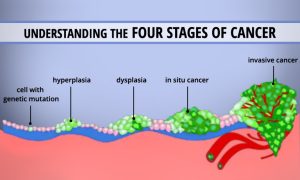Cancer, a complex and often daunting diagnosis, encompasses a multitude of diseases characterized by abnormal cell growth with the potential to spread to other parts of the body. One critical aspect in the management and prognosis of cancer is understanding its stages. Staging provides crucial information about the extent of the disease, aiding in treatment decisions and predicting outcomes. In this article, we delve into the various stages of cancer, shedding light on their significance and implications for patients and healthcare providers alike.

Stage 0: Carcinoma in situ
At this initial stage, cancer cells are confined to the layer of cells where they first developed and have not invaded surrounding tissues. Often termed as “pre-cancerous,” stage 0 indicates abnormal cell growth that hasn’t yet become invasive. Early detection and intervention at this stage offer the best chance of successful treatment and prevention of progression to invasive cancer.
Stage I: Localized Cancer
In stage I, cancer is small and confined to the organ or tissue of origin, with no evidence of spread to nearby lymph nodes or distant sites. Treatment options typically include surgery, radiation therapy, or a combination of both, with a high likelihood of cure, especially when diagnosed early. Regular follow-up is essential to monitor for any signs of recurrence.
Stage II: Locally Advanced Cancer
Stage II signifies that the cancer has grown larger or has spread to nearby tissues or lymph nodes but remains confined to the primary site. Treatment may involve more aggressive approaches, such as chemotherapy or targeted therapy, in addition to surgery and radiation. The goal is to eradicate any remaining cancer cells and reduce the risk of recurrence or metastasis.
Stage III: Regional Spread
At this stage, cancer has progressed further, invading nearby lymph nodes or tissues beyond the primary site. Treatment often requires a combination of surgery, chemotherapy, and radiation therapy, aiming to eradicate cancer cells both locally and regionally. Despite the advanced stage, curative treatment is still possible in some cases, particularly with multimodal therapy approaches.
Stage IV: Distant Metastasis
Stage IV represents the most advanced stage of cancer, where cancer has spread from the primary site to distant organs or tissues throughout the body. Treatment focuses on managing symptoms, controlling disease progression, and improving quality of life, as the goal shifts from cure to palliation. Therapeutic options may include chemotherapy, targeted therapy, immunotherapy, or participation in clinical trials exploring novel treatment modalities.
Recurrent Cancer:
In some cases, cancer may recur after initial treatment, either at the original site or in distant locations. Recurrence can happen at any stage, necessitating a reassessment of treatment options based on factors such as the site and extent of recurrence, previous treatments received, and the patient’s overall health status.
Understanding the stages of cancer is crucial for guiding treatment decisions, predicting outcomes, and providing patients with valuable information about their disease. From early-stage localized tumors to advanced metastatic disease, each stage carries its unique challenges and considerations. By leveraging advancements in diagnosis, staging, and treatment modalities, healthcare providers strive to offer personalized and effective care, ultimately improving the lives of individuals affected by cancer.


